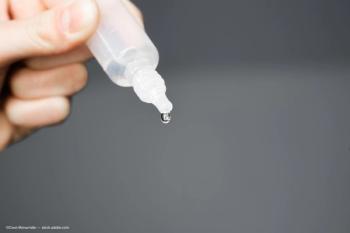
Alternative drug delivery for glaucoma close to prime time
The use of eye drops as a treatment for glaucoma will likely become rare considering the pace of progress in developing alternative drug delivery systems, said James D. Brandt, MD, to attendees of the 2018 Glaucoma Subspecialty Day.
“We have a treatment paradox in glaucoma. Although we have highly effective and proven topical treatments for the disease, many of our patients can’t, won’t, or don’t take the medications we prescribe,” said Dr. Brandt, professor of ophthalmology, Tschannen Eye Institute, University of California, Davis. “Sustained-release platforms will help us address this challenge.”
Dr. Brandt provided a status report on sustained release drug delivery platforms for glaucoma treatment. He noted that there are many approaches and technologies in development in laboratories and companies around the world. He focused, however, on investigational products that are in or are approaching phase III clinical trials.
Anterior chamber systems
Of all sustained-release delivery systems for glaucoma treatment, the erodible pellet releasing bimatoprost (Bimatoprost SR, Allergan) is the farthest along. The device is injected into the anterior chamber in an office-based procedure, and is designed to release drug continuously for at least 6 months.
“Published phase 2 data appear promising with sustained IOP-lowering maintained out to 6 months, and we are waiting for more data soon,” Dr. Brandt said.
Another anterior chamber implant is a titanium device containing travoprost (iDose, Glaukos). It is nondegradable and needs to be removed and replaced at an expected interval of every 6 to 12 months. So far, the only data about its performance are available in a company press release.
A third anterior chamber device is a microfabricated erodible implant that releases travoprost (Travoprost XR, Envisia Therapeutics). Preliminary encouraging data on this system were reported at ARVO 2018.
External systems
External sustained-release drug delivery products in development for the treatment of glaucoma include punctal plugs, of which a travoprost-eluting system (OTX-TP, Ocular Therapeutix) is now in a phase 3 trial. The product is designed to deliver the prostaglandin analogue to the tear film for up to 3 months. Favorable results from an unmasked pilot study including 17 patients were published in 2016.
Another external device is a ring that resides in the conjunctival fornix and releases bimatoprost over a 6-month period (bimatoprost ring, Allergan). The device, which is not bioabsorbable, must be replaced by a clinician when its drug load is released.
Time for a reality check
Dr. Brandt pointed out that when the alternative drug delivery systems come to marketplace, clinicians will need to consider several important issues.
Because data from postmarketing experience will be needed to better characterize variability in duration of action from patient to patient, it remains to be determined how often patients should return for follow-up to evaluate IOP control and the need for redosing.
“We don’t want to miss the patient whose IOP rises above target weeks to months before the labeled duration of action, and it will take a while before we understand how these platforms perform in the real world,” he said. “After all, we are treating asymptomatic disease and patients fall through the cracks. Home tonometry and other forms of continuous IOP monitoring should help.”
Reversibility in the event of a drug-related side effect is a particular consideration for devices implanted inside the eye.
“What are the consequences if a patient develops cystoid macular edema after implantation of a prostaglandin depot,” Dr. Brandt said.
Because it is known that IOP is often not controlled by a single IOP-lowering medication, Dr. Brandt stated that it will also be important that clinicians not overpromise a “drop-free life” for patients who are treated with the sustained-release products.
He also observed that implementation of injectable platforms introduces issues for workflow and safety that will not be addressed by phase III trials and will have to be sorted out once the products reach the market.
Broader potential
In addition to addressing the problem of medication compliance, an underappreciated aspect of the alternative delivery systems is that they might provide a platform for bringing new pharmacologies to the market.
“Most compounds that are promising in the lab never make it to the clinic,” said Dr. Brandt. “It may be that the delivery of some of these compounds in a sustained release manner may help us. The sustained release platforms now are just baby steps compared to where we are going in a decade. Watch this space and be ready.”
Disclosures:
Dr. Brandt has relationships with several companies that are developing sustained-release products for the treatment of glaucoma.
Newsletter
Don’t miss out—get Ophthalmology Times updates on the latest clinical advancements and expert interviews, straight to your inbox.









































